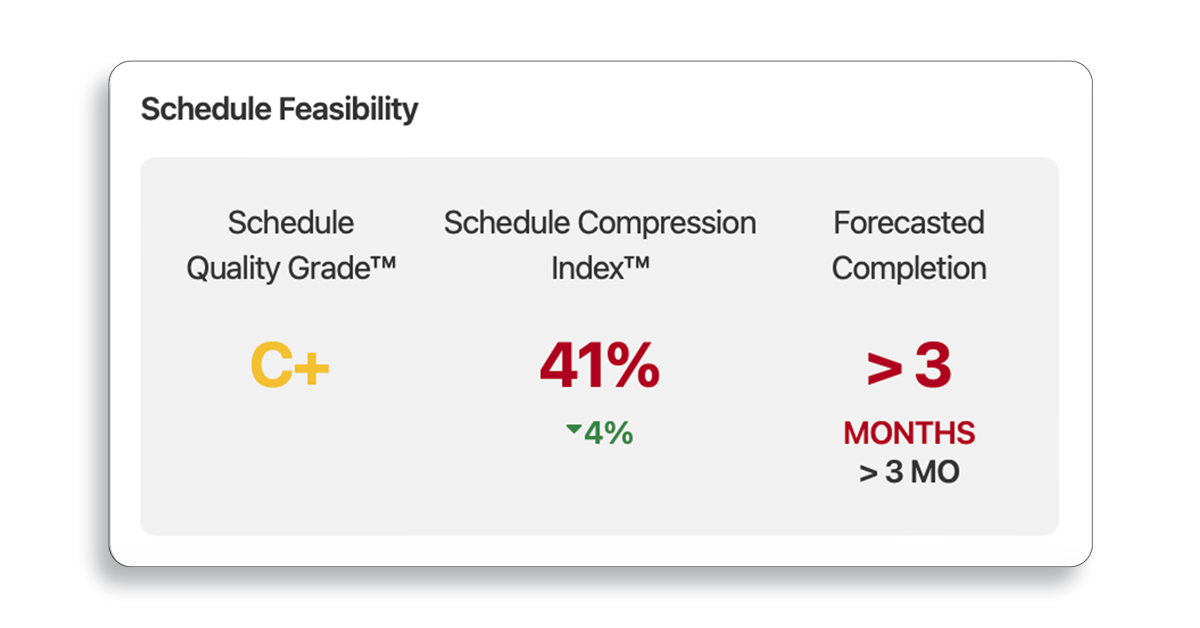Making sense of all of your data from all of your projects can feel like trying to understand a foreign language. But, when we break it down into steps, it starts to make a lot more sense.

- News
Project Predictability with Schedule Performance Index (SPI)
A common wish among many AEC professionals is predictability – a reaction to the general unpredictability of the industry. The state of the market, supply chain concerns, rising interest rates, and the skilled labor shortage are all exacerbating the challenges of achieving predictability. With many long-standing threats converging, the construction industry is amidst a “perfect storm.” In this landscape, adopting strategies and tools that provide clear foresight and stability is more crucial than ever.
Pause, Pivot, and Plan
The current environment is forcing many organizations to pause, pivot, and plan their upcoming project in more detail than ever before. One way to do so is with strategic, data-driven project management.
Effective management of construction projects requires accurate tracking and analysis of progress on-site. An essential metric for measuring project performance is the Schedule Performance Index (SPI).
Project managers gain valuable insight into the project’s health by calculating SPI based on Earned Value Analysis (EVA). Additionally, utilizing these metrics allows you to predict end dates more effectively.
What is SPI?
SPI is a performance metric that compares the actual progress of a project to the original plan. It gauges how far along the job is supposed to be versus how far along it is in reality.
You can effectively monitor and control project progress by utilizing Earned Value Analysis (EVA) to identify deviations from the planned schedule. SPI is calculated by dividing the Earned Value (EV) by the Planned Value (PV).
- EV represents the value of work accomplished.
- PV reflects the value of work planned to be done.

The SPI ratio quantifies the efficiency of work performed relative to the work accomplished. Once calculated, the ratio will tell you the following:
- SPI = 1: The project is on schedule.
- SPI > 1: The project is ahead of schedule.
- SPI < 1: The project is behind schedule.
SPI and Productivity Rate
SPI is invaluable for honing predictability. At its core, SPI represents the productivity rate of a project.
For instance, a project was anticipated to reach 85% completion, but in reality, it reached only 72%.

This gives the project an SPI of 0.85. An SPI of 0.85 means the project only achieves 85% of its planned productivity, indicating it’s behind schedule. If the SPI is consistently less than 1, as in this case, the remaining tasks will likely continue at the 85% productivity rate, potentially leading to an overrun.
To put it another way, if the productivity rate remains at 85%, a task projected to take 10 days would instead take approximately 12 days due to the reduced productivity.
With this understanding of SPI, stakeholders can make informed decisions. They might allocate more resources, reduce task durations, or adjust the project timeline. This ensures everyone involved has a clear picture of the expected project completion date.
How to Predict Project Outcomes with SPI
By applying the historical productivity rate, represented by the SPI, to the remaining duration of the project, you can gain insight into a more accurate project completion date. Using past data and earned value metrics can help forecast project end dates, but adhering to specific guidelines in the process is essential.
1. Be Accurate with Activity Durations
Every activity needs to have accurate duration estimates on both critical and non-critical path activities. Adjusting the schedule based on actual performance rather than hopeful expectations yields the best results.
2. Use High-Quality Schedules Throughout the Project
Before attempting to predict project outcomes, well-defined baseline schedules and their subsequent updates must be accurate. This is the only way to ensure that your reference point is valid enough to measure progress and calculate SPI throughout the project.
3. Track SPI Trends
Continuously monitoring and tracking SPI throughout your project helps identify patterns and trends in schedule performance. By analyzing SPI values at different project milestones or periods, you can assess if the project is consistently ahead or behind schedule.
4. Identify Deviations & Consider Project Factors
Taking into account various project factors that can impact SPI – such as changes in scope, resource availability, weather conditions, and unforeseen events – helps assess the potential impact of these factors on future project performance.
5. Forecast Future SPI:
You can predict future SPI values based on SPI trends throughout the project. For example, if the SPI has been consistently below 1, it indicates a likelihood of schedule delays. Conversely, if the SPI is consistently above 1, it suggests a potential for completing the project ahead of schedule.
6. Adjust Project Plans
By leveraging SPI and analyzing performance trends, project teams can make informed decisions about future project outcomes. This enables proactive decision-making, early identification of schedule risks, and effective mitigation strategies to keep the project on track.
Harnessing SPI for Enhanced Project Management

The drive towards improving predictability in the construction industry is not just a nice-to-have but an essential component to a project’s success. Enhanced predictability does more than just keep a project on track. It acts as a safeguard, reducing financial and safety risks while increasing stakeholder satisfaction. It also serves as a pivotal differentiator in a highly competitive market.
When construction firms like Manhattan Construction collaborate with advanced solutions such as SmartPM, they are not only tapping into cutting-edge technology but also fortifying their future. The success story of Manhattan and SmartPM showcases just how close we are to achieving impeccable precision–with a predicted end date nearly mirroring the actual completion. It’s a testament to what’s possible when the right tools are in play.
If you’re looking to bring this level of predictability to your construction projects, don’t wait. See for yourself how tools like SmartPM can transform your operations. By accurately predicting project timelines and costs, construction companies can make informed decisions, allocate resources more efficiently, and ensure successful project delivery.
RELATED STORIES

Making Construction Data Analytics Easier to Understand
Making sense of all of your data from all of your projects can feel like trying to understand a foreign language. But, when we break it down into steps, it starts to make a lot more sense.

Overcoming Confirmation Bias in Construction Project Management
Confirmation bias can be particularly problematic in project and schedule management, where decisions must be based on accurate and comprehensive information.

Top Construction Scheduling Software in 2023
SmartPM’s recognition as a top construction scheduling software in 2023 attests to the immense value in automated project controls.

Putting the ‘Smart’ in Project Management with Project Controls
Project controls are not just a subset of project management; they are its backbone, focusing on meticulous monitoring and analysis.

